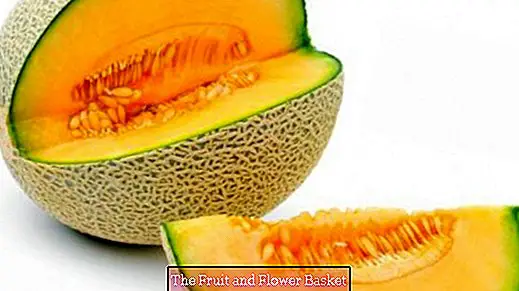The sugar melon - a vitamin-rich and healthy fruit
The sugar melon belongs to the cucurbitaceae family. The berry fruit, which is used as fruit, comes from tropical and subtropical areas.
Sugar melons are more closely related to cucumbers than watermelons, which are also members of the cucurbit family. The sugar melon is more related to the watermelon.
Sugar melon is an umbrella term for many melon varieties, it is very variable and they are available in many breeding forms. There are sweet cultivated forms that are used as fruit. Not sweet cultivars taste much like the cucumber and are used as vegetables.
The name honey melon, which is often used because of its sweetness, is actually a sugar melon subspecies.
characteristics
The sugar melon can be up to 4 kg heavy and head size. It is a low-calorie, sweet and delicious fruit. Depending on the degree of ripeness, it has only 25 to 50 kcal per 100 g of fruit.
The pulp contains many seeds that can be easily removed with a spoon.
Due to their particularly high vitamin C content, they are considerable vitamin bombs. They become a coveted thirst-quencher by a high water content of 94%, very similar to the watermelon.
Appearance
The sugar melon is an oval to round berry fruit, which is also referred to as Panzerbeere because of its thick shell.
The surface is different depending on the breed form. It can be smooth, reticulate or feel bulging. The color of the pulp is usually green or yellow, but it can also be white, orange or pink.
Different sorts
In Europe, the many breeding forms, over 500 varieties in the EU alone, are divided into three large groups:
Winter melons:
This includes the well-known yellow canary, also called Canari or yellow honeydew melon. Likewise the Amarillo liso, Piel de Sapo and Tendral.
They taste very sweet, can be kept for several weeks, have little odor and weigh 1.5-3 kg. The pulp is green-white and juicy.
Cantaloupe melons, also cantaloupe melon or muskmelon:
These include the varieties Charentais and Ogen.
They taste very fragrant, have a pronounced scent and are usually not durable for a few days.
Musk-melon:
They include the varieties Wester Shipper, Honey Dew, Galia and Easter Shipper.
They are fragrant, their flesh is orange to green and tastes more or less aromatic, depending on the variety. The shell of the melon is covered with a cork-like net, it is medium in size and round. It is usually stable for a long time (1-2 weeks).
Origin and cultivation
The origin of the sugar melon is not very sure. Their natural habitat is believed to be in the tropics of central and western Asia.
It is mainly grown in the Mediterranean countries of Spain, Italy, Israel, France and Portugal.
Recognize ripe sugar melon
The maturity can be recognized by the fact that the smell is slightly sweet and melon-like and when the end of the stem gives way with light finger pressure.
Mature fruits are hairless and bald, hairy sugar melons are immature.
Tips for storage
Although some types of sugar melons are more durable in the fridge, they lose their aroma, taste and vitamins when stored too long, so avoid it. Also, they can accept the taste of other foods.
Ideal are cool basements, at about 8-15 degrees. They should not be stored for more than 2 weeks.
You should wrap cut melons in cling film and use them within 1-2 days. You can also freeze sugar melons very well.
Use of sugar melons in the kitchen
Sugar melons, like the watermelon, are refreshing and hotly thirst quenchers. It is best eaten fully ripe and cool. To halve the fruit, remove the seeds with a large spoon, quarter them and cut them into small pieces.
The sugar melon is one versatile fruitthat gives many dishes a special touch:
It goes well with hearty things, such as poultry or crab salad, very delicious with goat cheese and raw ham. Also a delicious summer soup or a hearty chutney can be prepared from it.
Sweet you use them u.a. in ice cream or sorbet. If you puree it, it tastes great in milkshakes.
You can make melon punch with white wine or sparkling wine, of course also non-alcoholic, with juices and mineral water.
Conclusion: So once again a super delicious and healthy fruit, which must be tried, if not done so far!





